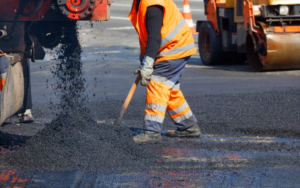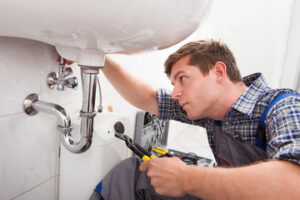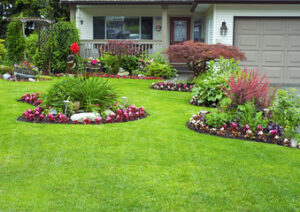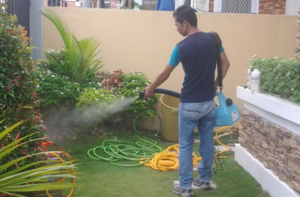Asphalt Paving Charleston SC builds or repairs roads and driveways with an asphalt mixture. This mixture includes aggregates and a binder that binds the aggregate together. The resulting mix is then compacted to improve its density and strength.
The choice of base material significantly impacts the durability and long-term performance of asphalt pavement. Some contractors prefer crushed stone, while others swear by gravel or sand.

Asphalt’s dark color helps improve the visibility of road markings in low-light conditions, making driving safer for everyone on the roads. Its skid-resistant surface further reduces the risk of accidents. And its water drainage properties help prevent standing puddles from damaging the surface over time, reducing the risk of hydroplaning.
Asphalt pavements are designed to last upwards of 20 years with proper maintenance. This durability allows for the use of thinner overlays, saving money in both construction and upkeep costs. Additionally, asphalt’s ability to flex under stress makes it well-suited for use in regions with extreme weather fluctuations. Its flexibility helps the surface to withstand rutting in the summer and harsh freeze-thaw cycles in the winter.
Newer technologies allow asphalt producers to produce warm-mix asphalt, which is mixed and spread at lower temperatures than hot mix (HMA). This drastically cuts fuel consumption and greenhouse gas emissions. It also increases worker safety and the product’s quality.
Another way to improve the durability of asphalt is by adding recycled materials into the mix. For example, used frying oil and residues from corn stover have been successfully used to decrease the high temperature grade of the asphalt mixture.
Unlike concrete, which requires a minimum of seven days to set up before it can be trafficked, asphalt can typically be paved, striped, and driven on in one afternoon. It is also less expensive to repair than other types of paving materials, as long as the damage is caught early and promptly addressed.
Asphalt is a sustainable material, as it can be recycled over and over again without losing its integrity. In fact, it is the most recycled material in America, and it can be reused again in the form of road construction or as a base for other projects, such as parking lots and driveways.
While most forms of damage to asphalt can be avoided through preventative maintenance and regular upkeep, it is important to know when it’s necessary to have your driveway or parking lot resurfaced. Our team can assess your current situation and recommend the right paving solution to fit your needs.
Increased Aesthetics
Asphalt is a versatile material that can be used in a variety of different applications. Whether it’s used for a residential driveway or a highway, asphalt has many advantages over other materials like concrete paving. Compared to other paving options, asphalt is more affordable and easier to install. In addition, it’s highly durable and can withstand heavy traffic for years.
In addition to the benefits of improved safety and durability, asphalt also offers a number of aesthetic benefits. For example, it is available in a variety of colors and can be used to create lane markings that help drivers navigate more efficiently. Additionally, the smooth surface of asphalt helps vehicles drive more smoothly and reduces noise pollution.
The pavement structure is made of a base, binder layer and driving surface. The preparation of the base is crucial to the performance and longevity of a pavement system. If the sub-grade is not properly prepared, it can degrade quickly, leading to base failure. This can occur for several reasons, including ground water, excessive load counts and inadequate design.
When constructing a new asphalt pavement, it is important to use the correct machinery. This includes milling machines that remove the old asphalt surface, pavers that lay the asphalt and compactors that ensure it is well-packed. Using the right equipment ensures that the pavement is constructed in an efficient manner and allows the asphalt to cure appropriately.
One of the most significant challenges in constructing new pavements is maintaining proper depth and bonding. This is particularly true in high-traffic areas. The weight of vehicles causes damage to the pavement, and if this is not corrected, it can lead to structural failure, such as rutting, raveling or corrugation. To prevent this, a process called resurfacing can be implemented. This involves putting a new layer of asphalt over the existing surface, which extends the life of the pavement and improves its appearance.
The asphalt pavements that are used in highways and busy urban roads need to have a high-performance mix that can withstand heavy traffic loads and harsh weather conditions. To meet these requirements, the asphalt mixture is characterized as hot mix asphalt (HMA), which consists of bitumen and various aggregates. It is heated to temperatures between 300 and 350 degrees Fahrenheit, which makes it easy to work with.
Cost-Effectiveness
Asphalt is one of the most affordable paving options available. It is also durable, meaning you will spend less money in the long run on repair and maintenance. Additionally, asphalt is easy to install and requires fewer resources than other materials. It’s important to note, however, that proper site preparation is essential. This may add to the overall project costs.
The type of asphalt mix used will also have a significant impact on pricing. Different projects require specific characteristics from the material, for example, highways and busy urban roads demand high-performance mixes capable of withstanding heavy traffic loads and harsh weather conditions. Residential driveways, on the other hand, are more likely to benefit from a mix that prioritizes aesthetics and cost-effectiveness.
Another factor that can contribute to cost-effectiveness is the use of warm mix asphalt. This technology allows for the asphalt to be produced at a much lower temperature than traditional hot mix asphalt, reducing energy consumption and eliminating fumes.
Once the paved surface is constructed, it’s important to properly compact the material to eliminate voids and ensure structural integrity. This step is typically done with heavy rollers. This step is especially important for new construction, as it helps to prevent future pavement failures such as rutting and cracking.
One of the greatest benefits of asphalt paving is its ability to reduce traffic noise. This is because it’s a very effective insulator, absorbing the sound waves that travel over the surface. This can be particularly beneficial in residential areas with a lot of traffic, where traffic noise may interfere with quality of life.
In addition to reducing noise, asphalt also promotes safety by providing a smooth and even surface for drivers. This helps to reduce tripping hazards and vehicle skidding, which can be especially dangerous for children and elderly people. Additionally, because asphalt is black in color, it offers a strong contrast against road markers and other colors, making it easier for motorists to see during inclement weather conditions such as rain or snow. The permeability of asphalt pavements also allow for water to easily drain and avoid pooling, which can lead to costly repairs.
Sustainability
The asphalt industry is constantly working to improve sustainability. Using reclaimed materials such as recycled aggregate and asphalt binder made with waste polymers and byproducts, reducing fuel consumption during construction, and utilizing innovative warm-mix technology are some of the many ways that the industry is contributing to a more sustainable future.
The use of reclaimed materials reduces the need for raw material production and lowers environmental impact by avoiding dumping waste products into landfills. Additionally, asphalt pavements require less energy to produce and emit fewer greenhouse gases during production than other paving materials.
Using recycled asphalt also means that the road surface doesn’t need to be removed and replaced after a certain number of years, which saves both time and money. Additionally, the elasticity of asphalt allows it to adapt to the changing climatic conditions and traffic loads that the road must withstand.
Another important aspect of asphalt paving that promotes sustainability is its ability to manage water flow and prevent a build-up of water underneath the road, which could result in the formation of heaves and ruts. This is especially important in areas with frequent freezing and thawing cycles.
Asphalt is a great material for reducing traffic noise pollution because it is very effective at absorbing sound waves. This will help to keep the noise levels down, which is beneficial for nearby residents and businesses.
While engineering performance is a key criterion for sustainable pavement, the social development and environmental protection pillars are often neglected. However, these factors should be included in life cycle analysis (LCA) to obtain an optimal balance of sustainability.
In a LCA, the material production stage is usually the biggest opportunity for sustainability improvements. For example, introducing WMA technologies or substituting neat binder with waste products like crumb rubber modifier (CRM), recycled plastics (RP) or vacuum tower bottoms can significantly reduce emissions and energy consumption during production.
The asphalt industry has been studying the effects of various environmental enhancements on pavement performances, such as rutting and moisture susceptibility, for years. These studies have shown that, in addition to reducing carbon footprint and energy consumption, better performance guarantees longer lifespans and lower reconstruction, maintenance and rehabilitation costs, which in turn reduce natural resources and fuel consumption over the long term.








